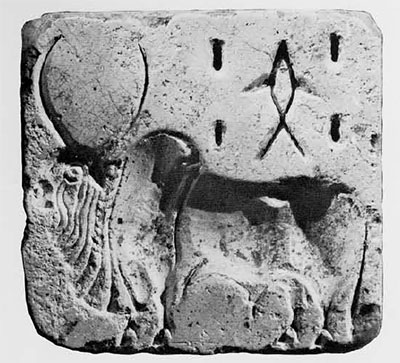
The introduction of the art of writing is recognized as one of the most crucial advances in the history of civilizations. Some scholars have asserted that without writing advanced civilization is impossible. Others have remarked that in antiquity there was virtual technological parity between barbarian and civilized communities and that the practice of writing was the principal token of advancement over the barbarians. These generalizations are perhaps too sweeping. There are, after all, important instances of highly developed, sophisticated cultures which were apparently dependent on oral tradition, memory and recitation rather than the written word. But usually, the introduction and development of writing does accompany the other factors—social, economic, religious, and technological—which have coalesced to produce the great civilizations of the world.
Writing can be described as a graphic counterpart of speech and thought. It provides a visual means of communication in a permanent or semipermanent form, which can be transported great distances or stored in archives to provide enduring records of human events. For the archaeologists and students of past societies, the existence of preserved ancient documents can provide the only objective evidence for answering the whys and hows to fill out the archaeological record. At best, the archaeological record is woefully incomplete and tells us virtually nothing about the intellect of ancient man. Just think how rich our knowledge and understanding of ancient Egypt, Mesopotamia, and the Classical World because of the preservation of both archaeological and written records. But there are other early societies, equally as impressive archaeologically, which stand mute and unintelligible giants before our curious eyes. In some instances the ancient populations were apparently non-literate, but in others the fault rests with us in our inability to decipher the records left to us.
So it is in South Asia where the earliest deciphered records date merely to the third century B.C. And yet archaeology has revealed the presence of a vast ancient literate civilization centered along the basin of the Indus River in what is now West Pakistan and western India. This Indus—or Harappan—civilization was thriving from at least 2400 to 1900 B.C. There are strong indications that it was in contact with the Persian Gulf region and the Sumero-Akkadian cultures of southern Mesopotamia.
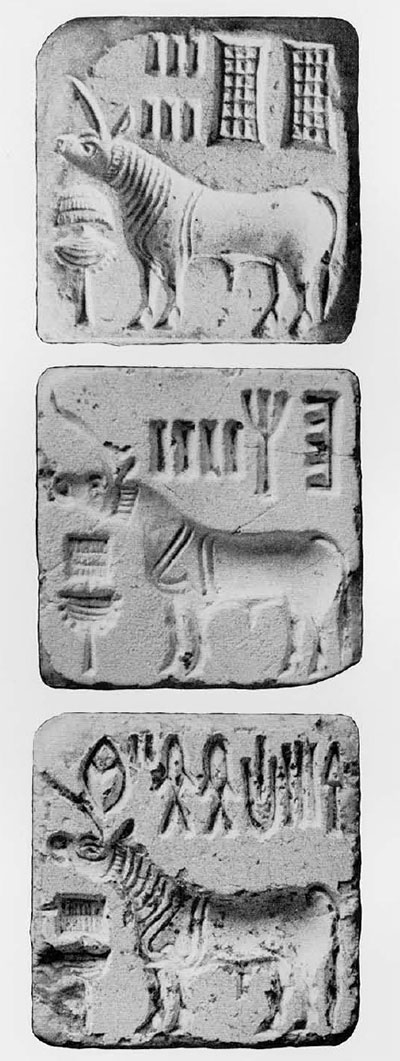
There is no doubt that the Harappans were literate, or had at least a literate social class. There are abundant examples of their script to verify this but as yet not a single word can be read. We know virtually nothing of the structure of the language nor do we even know to which linguistic family it belongs. This is not to say that valiant attempts have not been made to decipher it. Since the initial discovery of Harappan writing some ninety years ago, scholars and dilettantes alike have produced “decipherments” and “translations” which have associated the Harappan language with practically everything from Cretan, Egyptian, and Sumerian in the west, to Chinese in the north, to Sanskrit and Dravidian languages in South Asia, to Easter Island in the South Pacific. The story of these many “decipherments” is a fascinating one—both amusing at times and maddening at others. We find, for example, such puzzling “translations” as:
“This is the eight (formed) God one of whose sides (forms) (is) the sprinkled great fish”
or a “translation” of what is called the longest known Harappan inscription (although it may in fact be three short separate inscriptions!):
“The great god, who has the two sides (forms) of the high Sun of the eight (parts) of Orur, (which is) outside the land of the rain clouds of the (constellation or month of the) Scale, which approaches with peals of thunder, of the united lands of Minad (the country of the Fish), (is) the rain of the year of a house of brushes.”
These and other claimed decipherments are not accepted save by a few dedicated “believers,” and for good reasons. The primary problem is that all of the surviving inscriptions are too short to allow any analysis of the structure of the script and the language it represents. Most of the inscriptions consist of from two to five symbols, with a few having as many as ten. These curt notation give no hint as to their contents. Are they personal or place names, titles, or complete phrases or sentences?
Probably the most serios methodological error—and one which is still being made today—is to confuse the script with the language it represents. A script is but an agreed upon conventionalized system of notation of sounds, words, and ideas. Writers of completely unrelated spoken languages can, and often do, use simliar symbols in their scripts. This does not, however, imply that the similar looking symbols are pronounced the same or have the same meanings in the different languages. For just a simple example, compare the Russian letter P which is equivalent phonetically to English R, Russian C to English S, and H to N. But it is this amateurish comparing of scripts which has resulted in most of the absurd “translations” of the Harappan inscriptions.
There is yet another problem hampering any decipherment of the Indus writings and it is one that has unfortunately been created largely by the archaeologists themselves. Although there are hundreds of known inscriptions on seals, pottery, and small objects there is no clear chronological sequence of them to demonstrate a development in the script. We see it mainly in its mature stage. Only very recently have Indian archaeologists uncovered evidence for a late simplified stage of Harappan writing but the details are as yet unavailable. As for the early stages and the origin of the script, we have no positive evidence at all.
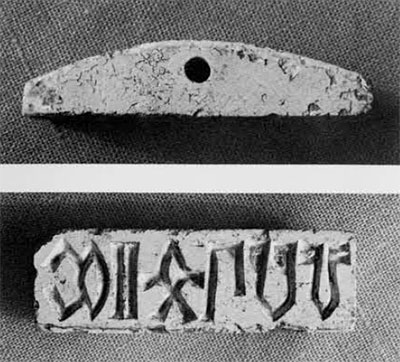
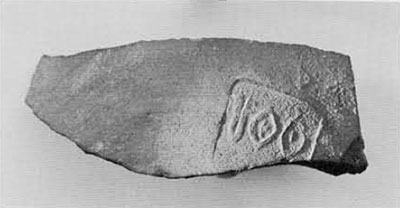
Most scholars agree that the “idea” of writing originated in Mesopotamia sometime before 3000 B.C. The Sumerians may have been the people responsible for this epical “discovery.” If they weren’t the originators, they were at least the ones who adopted and developed the art of writing for the first time in the world’s history. The overall evidence suggests that from this successful beginning, the practice of writing spread to many other countries in the Near East. The important question then arises as to whether it might have spread even as far as the Indus Valley. This is a likely possibility but there are presently too many links missing in the chain of transmission. Someday the archaeologist’s spade will unearth the answer to this question, perhaps in southern Iran or southern West Pakistan.
In the meantime, all we can meaningfully do is to continue the study of the Harappan script, as a script alone, and refrain from overzealous efforts to “decipher” it. There is still need for more detailed analyses of the groupings and arrangements of the symbols and of the possible connections between the inscriptions and the types of objects on which they are found. As a start in that direction it may be helpful to describe the material evidence available for any study of the Indus script. There are at least ten different types of objects upon which are found examples of the script.
Most numerous are the stamp seals which apparently served the same basic function as the well known cylinder seals of Mesopotamia—that of personal identification of ownership. These Harappan stamp seals, made of steatite, are one of the hallmarks of Harappan civilization. The most common variety is square in shape and depicts an animal in relief above which is an inscription. A second variety is rectangular or square in shape and contains only script.
Logically we should expect to find impressions of such seals. And indeed there are lumps of clay, stamped with seal impressions, which were originally sealings around the mouths of jars or on bundles of goods wrapped for shipment. Impressions of seals are also seen on certain types of pottery goblets. As far as I know, such impressions on pottery display only script, and none of the animal representations.
Next we find numerous examples of Indus script scratched into the surface of pottery. Such scratchings are usually crudely done on the body of vessels or more carefully executed on the rims. The significance of these incised inscriptions escapes us.

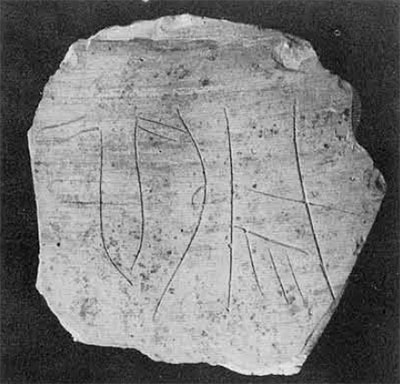
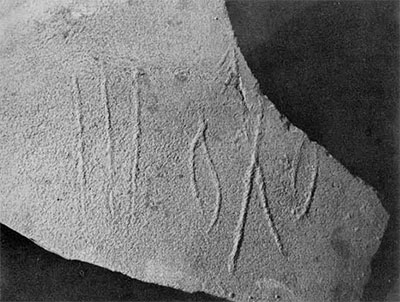
More suggestive, however, are examples of script on the bottom halves of large storage jars. The bottoms of these jars were apparently formed in an open mold. The script on the jars is seen in raised relief. This can only mean that the original inscription was incised into the mold and that every vessel made in such a mold would bear the same inscription. Indeed, several sherds displaying identical raised script were found during the 1964-65 University Museum excavations at Mohenjo-daro.
Inscriptions are also found on metal objects. Copper or bronze blades, axeheads, and small flat plates sometimes have several scratched on them. There are not enough examples unfortunately to allow conclusions as to the relationship between the inscriptions and the types of objects.
Another class of objects does, on the other hand, have potential significance for the use and early development of the script. There is a relatively large collection of tiny steatite seals or amulets of various shapes found only in the lower and earliest levels of Harappa. The signs seen on these objects are quite limited in number but those that do appear seem to have the same form as the signs on the later stamp seals.
There is a very interesting class of baked clay objects which must have been amulets or some such thing rather than seals. These objects are in the shape of short rods or sticks having either a triangular or round cross section and carrying script and pictures in raised relief. One fine example of a triangular sectioned object was discovered during the Museum’s excavations at Mohenjo-dar0. One side depicts an Indian crocodile (gavial or gharial) with a fish in its jaws, the second side depicts a rare example of a boat, and the third side has script.
Harappan sites contain hundreds of ivory and bone objects. Among these are rods or sticks decorated with incised geometric patterns. A few examples have beautifully engraved script. The interesting fact about these inscribed sticks is the striking similarity among their inscriptions. In the majority of examples, the last two symbols at the left ends of the sticks are identical. One is tempted to see here some definite correlation between the inscriptions and the objects—either the type of object, the material of which they are made, or the use of them.
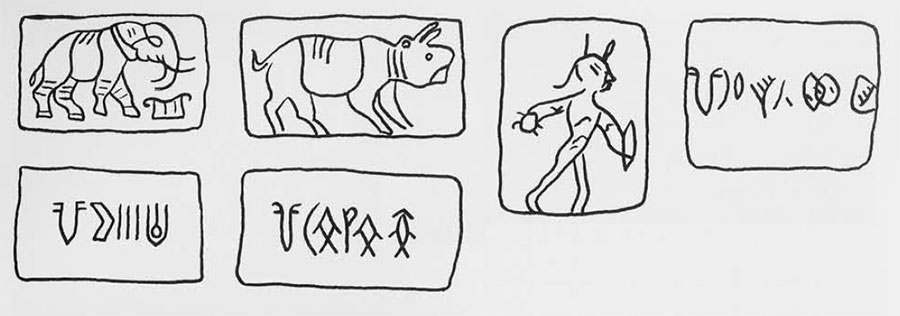
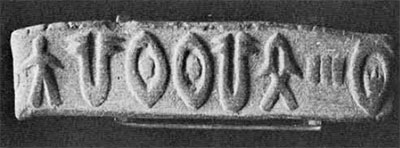

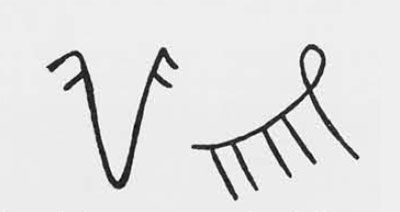
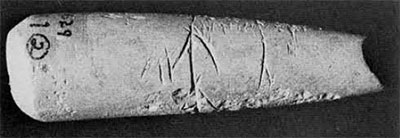
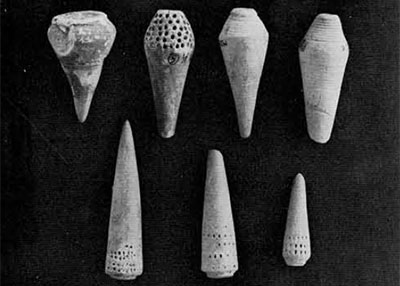
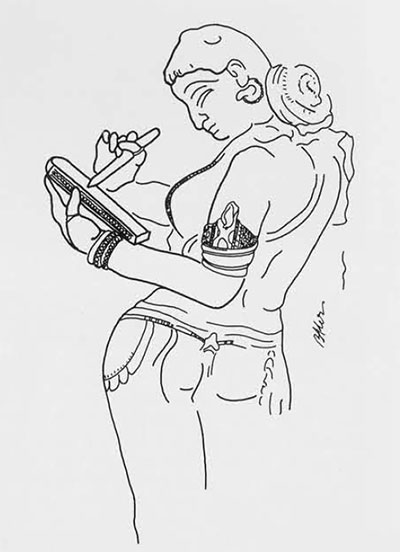
Lastly, HArappan script is sometimes found scratched into the sides of baked clay cones. These cones are themselves especially intriguing. Averaging about two and a half inches in length, they often resemble stylized shells. In fact, several cones actually made of shell have been found. These cones are ubiquitous and very numerous at Harappan sites but their purpose has never been explained. Only one suggestion might be made here. The tips of the cones are characteristically worn flat on one or more sides, indicating that they did have a functional purpose. Now one of the most enigmatic questions concerning the Harappans is what did they write on in everyday life and what did they write with. After all, the inscriptions we study today represent only a fraction of the original written records of the Harappans. There must be lost a vast collection of writing on less durable materials than stone and baked clay—such perhaps palm leaves, bark, wood, cloth, leather, or wax tablets. Is it unreasonable to suggest that these clay cones with their worn tips might have been the instruments with which the writing was executed? It is always dangerous and presumptuous to bring in parallels from places and times far removed from the subject, but here a most tempting parallel can be suggested from later Indian sculpture. A provocative sculpture from 10th-11th century A.D. Khajuraho in northern India depicts a woman writing on what may have been a wax tablet with a cone-shaped stylus. Could this late sculpture equally as well have portrayed an inhabitant of Mohenjo-daro or Harappa three thousand years earlier writing a text which is now eternally lost?
This then is a brief survey of the known surviving evidence for the earliest writing in South Asia. Its origins and early development, its decipherment, and its possible connections with later Indian scripts are virtually unknown to us. Minor breakthroughs in our knowledge of these questions are continually being made but it is doubtful that we will ever be able to write a literary, economic, religious, or administrative history of the HArappans. The archaeologist dealing with the ancient Harappan civilization must remain envious of his colleagues in Egypt, most of the Near East, and parts of the New World who have decipherable ancient records to supplement the mute archaeological remains. “All the horses and all the King’s men” will never enable us to penetrate into the Harappan intellect if we are permanently denied an understanding of their written words. A passage from Goethe’s Faust sums up the archaeologist’s dilemma:
“Ye instruments, forsooth, ye mock at me,—
With wheel, and cog, and ring, and cylinder;
To nature’s portals ye should be the key;
Cunning your words, and yet the bolts
ye fail to stir.
Inscrutable in broadest light,
To be unveil’d by force she doth refuse,
What she reveals not to ty mental sight
Thou wilt not wrest from her with levers and with screws.”
